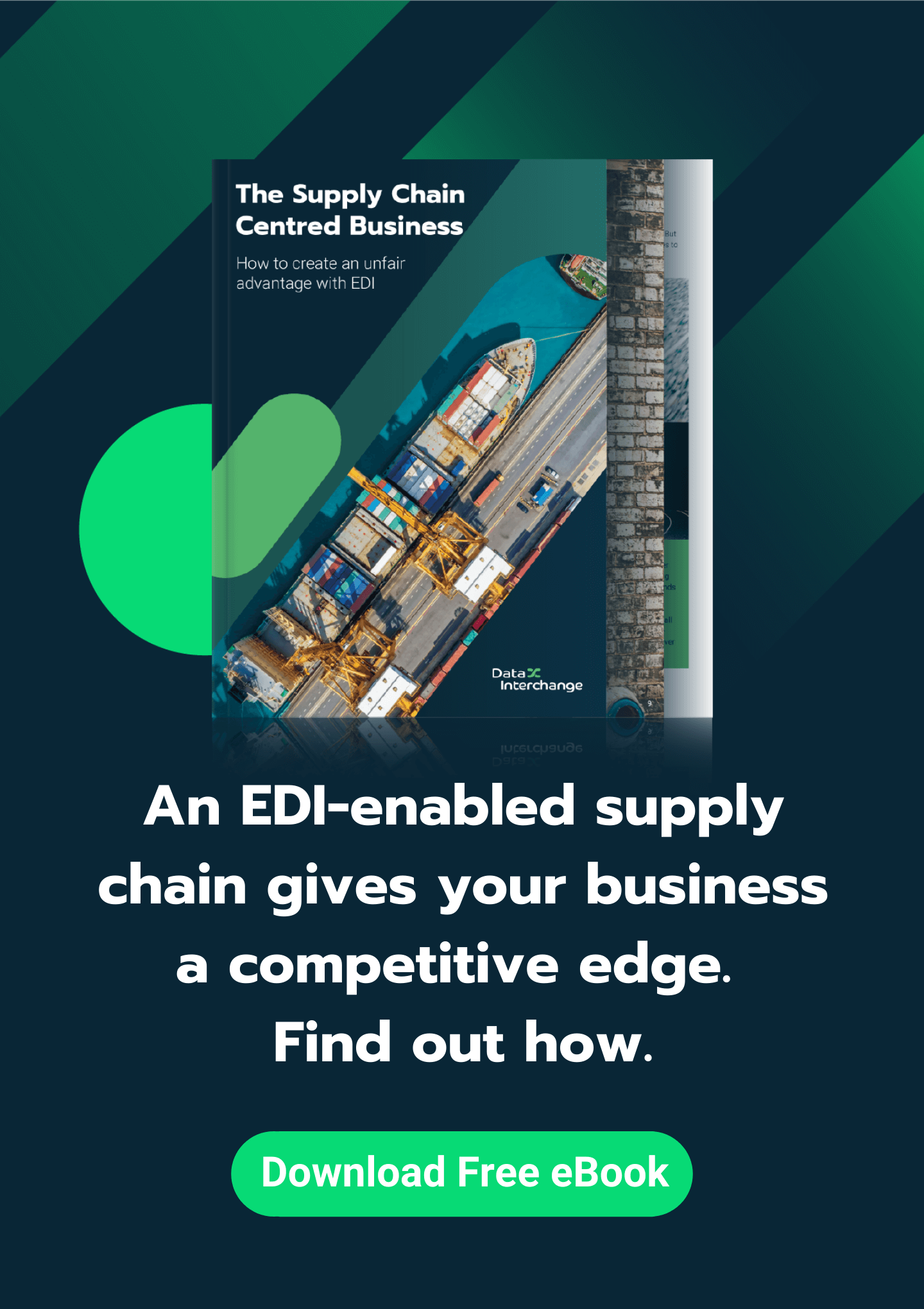Different Types of EDI Compared
Global supply chains have always been complex, but 2020 revealed both the fragility and central importance of supply chain management. In a year of rapid change, the businesses that responded quickly and flexibly were the same businesses that recovered quickly and thrived in the new normal. In many cases, these success stories boiled down to excellent supply chain management.
In 2020, supply chains are no longer relegated to the back office — rising customer expectations means that they’re now front and centre, playing an integral role in your organisation’s commercial success. Electronic Data Interchange (EDI) — a system of exchanging business documents electronically — is core to capturing the visibility, control and optimisation necessary to make effective strategic and tactical choices within the global economy.
Getting your EDI choices right is critical to creating a more stable future, strategically and tactically aligning your business with supply chain realities, and harnessing efficiencies to drive competitive advantage. At Data Interchange, we pioneered some of the first EDI systems in the UK and Europe. We’ve also spent more than fifty years helping businesses across the economy maintain supply chain relationships. From this perspective, we are going to explain and compare the main types of EDI and provide insight into which type could be right for your business.

EDI Type 1: Direct EDI/Point-to-point
Direct EDI, also known as point-to-point EDI is the oldest and most traditional form of EDI. It’s often deployed on-premise and delivers a direct line of communication between two businesses through an EDI software package that utilises agreed-upon protocols, including AS2, OFTP or SFTP.
Benefits & drawbacks of this type of EDI
When you use on-premise EDI, you are in full control. You can service the platform yourself, which means you do not need to wait around for third-party support teams. There are also no additional costs. By comparison, if your EDI is not on-premise, you will usually pay for data and hosting services.
For many businesses, the downside to communicating individually with each business partner is managing potentially hundreds or thousands of separate connections. Throw different communications protocols into the mix and things can grow even more complicated, as your system must be able to support each of these protocols. Remember, you need to accommodate every EDI standards used within your supply chain — e.g, EDIFACT, VDA, X12, to name just a few.
Managing these inevitable complexities requires a competent team with the right skills. However, finding and maintaining such a team can be challenging due to EDI skill shortages — as many as 29% of businesses state they lack the resources to build and maintain integration in-house. It’s important to note that Direct EDI requires the most in-house expertise of any of the options on this list.
Who should use this type of EDI
Direct EDI is most commonly used between larger customers and suppliers with significant numbers of daily EDI transactions. These solutions are best suited for businesses with in-house expertise and a limited number of stable supply chain relationships. If you do want a Direct EDI system, consultancy services like those offered at Data Interchange could help you set up a point-to-point solution. But, ultimately, you are left in charge of managing your own system — unless the system is part of a managed solution, which we’ll elaborate on a bit later.
Pro Tip: If you lack the right skills in-house, a direct EDI solution is probably not the right choice.
EDI Type 2: EDI via VAN
Probably the most common type of EDI used today is EDI via Value Added Networks (VAN). EDI via VAN is a cloud-hosted solution that deploys private networks provided by EDI specialists (or VAN providers) to connect you and your trading partners. The VAN provider manages the network and provides organisations with ‘mailboxes’ where you can send and receive EDI documents, such as purchase orders and invoices.
Benefits & drawbacks of this type of EDI
As compared to a Direct EDI solution, a VAN is much more flexible, particularly when it comes to managing a large number of different relationships or turnover within your supply chain. Fundamentally, EDI via VAN can reduce your risks, minimise your costs and increase your efficiency.
However, using a VAN does not eliminate all of your problems. You lose some degree of control over the flow of your data once sent into the VAN, and are effectively adding another step in the chain that is really just a middle man. You still need to ensure effective connection to the VAN, and its use by your supply chain partners. It’s also worth remembering that your customers will each have their preferred B2B data communication methods — once again, this means many different standards and communication protocols. Depending on the VAN in question, these may or may not be supported, and you need to ensure that compatibility.
What to look for in this type of EDI solution
When looking for a Web EDI solution, you’ll want to find a product that offers intuitive dashboards, simple upload tools and fully integrated functions. Our Web EDI software, Darwin Hub, delivers these, as well as the core functionality required to enable your suppliers to exchange standardised data with only a web browser. Darwin Hub also seamlessly integrates with your internal business systems, tailoring the EDI environment to meet with your business rules, processes and specifications. Darwin Hub can help your business:
- Drive efficiency, with supplier data automatically integrated into your internal systems.
- Simplify order processing and increase accuracy.
- Streamline on-boarding processes for suppliers, increasing adoption of EDI across your supply chain.
- Remain flexible and future-proof by making it easy to add more suppliers to the web portal.
Who should use this type of EDI
The simplicity of WebEDI beings brings a number of benefits to businesses throughout a supply chain. The install-and-go nature of web tools make them a great choice for businesses working with less tech-savvy partners or those in countries/regions where EDI and other IT skills are in short supply. For any organisation with supply chain partners that have limited EDI expertise, WebEDI can be an essential tool for integrating those partners within a complete EDI system.
Fundamentally, Web EDI is a critical tool for any business with limited EDI expertise — consider how it can benefit you and your supply chain partners.
EDI Type 3: Web EDI
Web EDI takes the simplicity of a VAN solution one step further. WebEDI can be used in tandem with almost all of the other strategies here. Still, we’re separating it out here, as the term represents a growing number of tools that operate from web browsers and dramatically reduces the learning curve for effective deployment of EDI.
Benefits & drawbacks of this type of EDI
The primary benefit of Web EDI tools is simplicity — they offer more automation and a simpler interface. For example, a lot of Web EDI tools are defined by browser-based duplicates of paper-based forms — allowing users with no EDI experience to input details. Those forms are then used to automatically generate an EDI request and automate all of the backend technical processes.
The fact that Web EDI is browser-based is central to the simplicity it offers. It also removes any installation configuration process to minimise challenges with integration. Effectively, Web EDI works like a SaaS tool in so much as it delivers, as-a-service, over the internet. Although you could make a similar comparison for EDI via VAN.
Who should use this type of EDI
The simplicity of WebEDI beings brings a number of benefits to businesses throughout a supply chain. The install-and-go nature of web tools make them a great choice for businesses working with less tech-savvy partners or those in countries/regions where EDI and other IT skills are in short supply. For any organisation with supply chain partners that have limited EDI expertise, WebEDI can be an essential tool for integrating those partners within a complete EDI system.
Fundamentally, Web EDI is a critical tool for any business with limited EDI expertise — consider how it can benefit you and your supply chain partners.
Pro tip: Web EDI can form one part of a “hybrid EDI model” that pulls on different types of EDI within an integrated solution. This is a great option when partnering with many different suppliers and customers, all with different EDI requirements. However, you need to make sure that each component of a hybrid solution is able to work seamlessly together in order to avoid manual or ad-hoc processes that could undermine the effectiveness of the system as a whole.
EDI Types 4: Managed EDI service
In a new global and digital era, the most responsive and digitally advanced supply chains will inevitably come out on top. EDI-as-a-service is a direct route to harnessing this competitive advantage. When EDI is delivered as a service, it can bundle different types of EDI and deliver that bundle as a seamless outcome for you.
Benefits & drawbacks of this type of EDI
As a methodology, EDI has always promised to take the challenge and pain points out of supply chain management. However, as pointed out in previous sections, the complexity of the EDI ecosystem often works against this goal. Different types of EDI need to be deployed for different reasons — and engaging with multiple EDI standards and protocols is essential.
Partnering with a managed service completely removes all complexity — even where different EDI protocols are used. A managed service will configure your implementation, promote business continuity and ensure risk-free outcomes. This frees you up to focus on your core business.
Partnering with a managed service also solves fundamental EDI problems by enabling your system to:
- Scale up or down to meet demand: chains must be built with continuous changes and exogenous shocks in mind. Managed services help you create responsive, flexible routes within the network to mitigate risk.
- EDI in-house skill shortages: EDI is a fundamental technology required in the marketplace, but it is also a niche technology. As a new generation moves into the industry, an EDI skills gap will inevitably emerge, making it more difficult to recruit and retain EDI experts. Cloud-based tools and mobile EDI apps can help reduce the learning curve, but you will need to spend time and money training new staff. However, partnering with a managed service guarantees that you will have the experts you need on-hand.
- Benefit from 24/7 support: Again, many businesses struggle to find and retain any EDI talent, much less enough talent to provide 24/7 support. Partnering with a managed service gives you instant, around-the-clock access to the expertise you need when you need it.
Who should use this type of EDI
Managed solutions allow businesses large and small to overcome the most complex supply chains while experiencing seamless outcomes. Also worth noting is that managed solutions give businesses an easy avenue to build a hybrid solution, combining elements of multiple types of EDI to improve the flexibility of supply chain relationships. Finally, managed solutions allow businesses to overcome the EDI/IT skills shortage and free up internal resources to focus on core business competencies and outcomes.
The future of EDI: Simpler, flexible and automated EDI-as-a-Service
Most EDI trends point towards greater inclusion of purpose-built tools and services that simplify access and utilisation of EDI. Although there isn’t one term for this trend, it’s something that we refer to as “EDI-as-a-Service”.
EDI-as-a-Service is sometimes used to reference managed EDI services. Although the use of managed service is helpful, the change occurring within EDI is broader. Web EDI, for example, is a significant development that is mostly defined by using cloud-based tools — it’s effectively EDI SaaS (Software-as-a-Service). And managed services increasingly deployed these cloud-based tools within their service offerings to improve customer experience.
Using the best part of each type of EDI
Although it’s worth thinking about different types of EDI, the future of EDI will certainly be defined by hybrid models that deploy multiple types of EDI within a single system that is simplified by technology. EDI-as-a-Service can be broadly thought of as the convergence of these two trends. First, the use of SaaS tools to simplify EDI access; and, second, the increased deployment of managed service to deliver EDI as an outcome.
Together, both of these trends simplify EDI adoption and management, allowing you to focus on what really matters — using EDI to improve supply chain relationships and drive commercial success. Don’t lose sight of that end goal. In 2021 and beyond, supply chains are set to take centre stage. Now is the time to harness their power to your advantage. Data Interchange can deliver solutions to meet the specific needs of both you and your supply chain — no matter the complexity involved.



























































































































